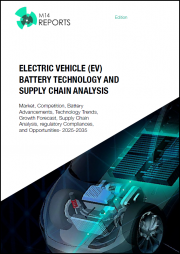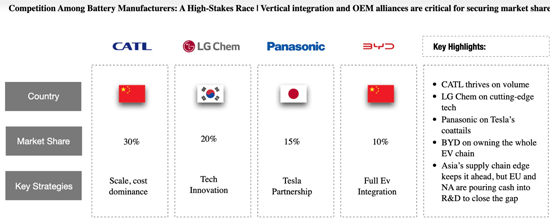
전기자동차(EV)는 세계를 보다 친환경적인 내일로 이끌고 있으며, 배터리는 이 혁명의 핵심입니다. 수요 급증에 따라 향후 10년은 기술, 시장, 경쟁의 격변이 예상됩니다.
전기자동차 산업은 향후 5-10년 동안 큰 도약을 이룰 준비를 하고 있습니다. 판매량이 급증하여 2030년에는 전 세계 신차 판매량의 20-30%를 차지할 것으로 예상되며, 이는 2020년의 4%에서 급상승할 것으로 예상됩니다. 이 붐은 배터리 비용 절감, 방대한 충전 네트워크, 화석연료 자동차에 제동을 거는 정부 정책에 달려 있습니다. 배터리의 에너지 밀도는 두 배로 증가하고, 항속거리는 500마일을 초과할 수 있으며, EU 국가 등은 2035년 내연기관차 퇴출을 목표로 하고 있으며, 전기자동차 보급에 박차를 가하고 있습니다.
현재 리튬이온 배터리는 니켈-망간-코발트(NMC)가 긴 항속거리를 실현하고, 리튬인산철(LFP)이 비용을 절감하고 안전성을 높이는 등 리튬이온 배터리가 그 정점에 서 있습니다.
리튬이온의 변형:리튬 니켈 망간 코발트 산화물을 사용하는 NMC 배터리는 에너지 밀도가 높고 일반적이지만, LFP 배터리는 2023년 용량 기준 세계 시장 점유율 41%를 차지할 것으로 예상되며, 더 저렴하고 지속가능한 배터리입니다. <>LFP의 채택은 에너지 밀도가 낮고 비용이 저렴하기 때문입니다.
신기술:2023년 BYD, CATL 등 기업이 양산에 돌입한 나트륨 이온 배터리는 도시형 전기자동차 및 고정형 축전지에 적합하며, 비용을 20% 절감할 수 있는 가능성이 있습니다. <>Toyota와 퀀텀스케이프가 개발한 고체 배터리는 더 높은 에너지 밀도와 안전성을 약속하지만 아직 실용화되지 않았습니다.
혁신듀얼 이온 배터리(DIB)와 양극성 LFP 배터리가 등장하여 급속 충전과 고전압을 실현하고 있지만, 사이클 수명에 대한 과제가 남아있습니다.
솔리드 스테이트 배터리는 EV의 주행거리를 600마일 이상으로 늘릴 수 있지만, 비용이 비싸기 때문에 리튬이온이 앞으로 10년간은 주도권을 쥐게 될 것입니다.
중국: CATL(2024년 세계 점유율 37.9%), BYD(17.2%)와 같이 생산비용이 낮은 기업이 주도. 생산비용이 저렴한 LFP 배터리가 주류이며, 2023년 전기자동차 판매의 3분의 2가 이 화학물질을 사용하게 될 것입니다.
북미: 미국은 테슬라, 포드와 SK온 등의 제휴에 힘입어 2021년 이후 2100억 달러의 투자를 유치하고 있습니다. 그러나 생산비용은 중국보다 20% 더 높습니다.
유럽: 높은 비용(중국보다 50% 더 높음)과 취약한 공급망이라는 문제에 직면하고 있으며, Northvolt의 파산은 2030년까지 35-40개의 기가팩토리를 건설하는 것을 목표로 하고 있습니다.
아시아태평양: 인도와 한국과 같은 신흥 시장이 성장하고 있으며, 인도에서는 2023년 EV 등록이 전년 대비 70% 증가할 것으로 예상되며, FAME II와 같은 제도가 이를 지원하고 있습니다.
전기자동차 배터리 시장은 지정학적 체스판입니다. 중국은 세계 생산량의 70% 이상을 차지하고 있으며, CATL과 BYD와 같은 대기업이 규모와 보조금으로 힘을 발휘하고 있습니다. 일본과 한국이 그 뒤를 잇고 있으며, Panasonic과 LG화학이 Tesla와 현대와 같은 브랜드에 전력을 공급하고 있습니다. 유럽은 뒤늦게 따라잡기 위해 유럽 배터리 얼라이언스(European Battery Alliance)에 자금을 투입하여 독자적인 공급망을 구축하기 위해 노력하고 있습니다. 북미는 테슬라의 네바다 기가팩토리를 필두로 아시아 의존도를 줄이기 위해 국내 생산을 강화하고 있습니다.
각 지역의 생산 능력 스냅숏
| 유형 | 장점 | 단점 | 채택 |
|---|---|---|---|
| NMC | 높은 에너지 밀도(-250Wh/kg) | 고가(코발트 의존성) | 감소 추세(Tesla, GM이 단계적 폐지) |
| LFP | 저렴한 가격,긴 수명,코발트 없음 | 낮은 에너지 밀도(-180Wh/kg) | 우세(Tesla, BYD, 포드) |
| 솔리드 스테이트 | 초고에너지 밀도(-500Wh/kg) | 아직 실용화되지 않음 | Toyota, QuantumScape 2026-2030년 목표 |
| 지역 | 현재 용량(GWh) | 2030년 예측(GWh) | 2035년 예측(GWh) |
|---|---|---|---|
| 아시아 | 500 | 1500 | 3000 |
| 유럽 | 50 | 400 | 800 |
| 북미 | 100 | 300 | 600 |
배터리 제조업체들의 경쟁은 치열합니다.

CATL은 물량으로, LG화학은 첨단 기술로, 파나소닉은 테슬라의 뒤를 이어, BYD는 전기자동차 체인 전체를 소유함으로써 성공을 거두고 있습니다. 아시아는 공급망에서 우위를 점하고 있지만, 북미와 유럽은 그 차이를 좁히기 위해 연구개발에 자금을 투입하고 있습니다.
CATL과 BYD가 독점하고 통합된 공급망과 저비용의 혜택을 누리고 있는 중국이 주도하고 있으며, 2024년 CATL의 339.3GWh 설치는 CATL의 주도권을 강조하고 있습니다.
LG Energy Solution과 같은 북미 기업이나 Northvolt와 같은 유럽 기업은 유럽의 높은 비용(중국보다 50% 더 높음)과 취약한 공급망이라는 문제에 직면해 있으며, 2024년 Northvolt의 파산은 이러한 어려움을 더욱 부각시키고 있습니다.
Tesla, BYD, 전통적인 OEM(GM, Volkswagen)과 같은 기업은 가격, 혁신성, 공급망 관리로 경쟁하고 있으며, Tesla 시장 점유율은 경쟁으로 인해 2019년 17%에서 2022년 13%까지 하락했습니다. 기가팩토리와 같은 업종은 비용 우위를 가져다 줍니다.
아시아 기업, 특히 중국 기업은 틈새 시장(저렴한 소형차 등)과 정부 보조금을 통해 공간을 확보하여 유럽 시장을 파괴하고 있습니다. 그들은 온라인 판매와 커뮤니티 형성 전략을 활용하고 있습니다.
전기자동차(EV) 시장에서는 기존 자동차 제조업체와 신생업체들이 치열한 경쟁을 벌이고 있으며, Tesla, Volkswagen, General Motors(GM)와 같은 업계 선두주자들은 자신들의 입지를 강화하기 위해 적극적인 전략을 추진하고 있습니다. 생산을 수직 통합하여 자급률을 높이고, Volkswagen은 Northvolt와 협력하여 안정적인 배터리 공급을 확보하며, GM은 대중 시장용 전기자동차 개발에 집중하여 고객층을 넓히고 있습니다.
동시에 전기 트럭에 특화된 리비안(Rivian), 고급 전기자동차 부문을 겨냥한 루시드 모터스(Lucid Motors)와 같은 신규 진출기업도 혁신적인 디자인과 첨단 기술을 활용하여 시장 점유율을 확보하며 시장에 진입하고 있습니다. 이러한 경쟁 구도에서 성공의 중요한 결정 요인은 배터리의 안정적이고 충분한 공급을 확보할 수 있는지 여부입니다.
Rivian과 같은 신규 진출기업은 기존 자동차 제조업체를 혼란에 빠뜨릴 수 있지만, 이는 공급이 부족한 세계에서 배터리를 확보하는 경우에만 가능합니다.
전기자동차 배터리 시장은 전동화가 정착됨에 따라 수요가 급증하며 기하급수적으로 성장하고 있습니다. 현재 아시아가 선두를 달리고 있지만, 유럽과 북미는 투자와 혁신을 통해 그 격차를 좁혀가고 있습니다. 가격 변동과 경쟁은 도전이 되고 있지만, 혁신과 적응을 위해 노력하는 기업에게는 기회가 넘쳐나고 있습니다. Tier 1 공급업체와 배터리 제조업체들이 가야 할 길은 분명합니다. 내일의 전기자동차에 전력을 공급하기 위해 기술에 투자하고, 공급망을 확보하며, 지속가능성을 수용하는 것입니다.
세계의 전기자동차(EV) 배터리 기술 시장에 대해 조사했으며, 시장의 개요와 기술 동향, 시장의 전망과 예측, 과제, 경쟁 구도 및 시장에 참여하는 기업의 개요 등을 정리하여 전해드립니다.
Lithium-ion (LFP and NMC) and Emerging Battery Technology (Solid-state and Sodium-ion) Market Sizing, Regional breakdown, Regulatory Policies, Battery-as-a-Service Model (BaaS), Gigafactories, Trends & Dynamic, Supply Chain Analysis, Competition.
This comprehensive study examines the -
Electric vehicles (EVs) are steering the world toward a greener tomorrow, and their batteries are the beating heart of this revolution. With demand skyrocketing, the next decade promises seismic shifts in technology, markets, and competition.
This report unpacks the electrifying future of EV batteries-where we're headed, who's leading the charge, and how manufacturers can stay ahead in this high-voltage race.
The EV industry is gearing up for a massive leap over the next 5 to 10 years. Sales are expected to surge, with EVs potentially claiming 20-30% of global new car sales by 2030, a steep climb from 4% in 2020. This boom hinges on shrinking battery costs, sprawling charging networks, and government policies slamming the brakes on fossil-fuel vehicles. Battery energy density could double, pushing ranges beyond 500 miles, while ultra-fast charging slashes wait times to mere minutes. Countries like those in the EU are eyeing 2035 to phase out internal combustion engines, turbocharging EV adoption.
"The EV tipping point is near-by 2030, one in three new cars could be electric, driven by cheaper batteries and a global push to ditch gas guzzlers."
Today, lithium-ion batteries reign supreme, with Nickel-Manganese-Cobalt (NMC) delivering long ranges and Lithium Iron Phosphate (LFP) slashing costs and boosting safety.
Lithium-Ion Variants: NMC batteries, using lithium nickel manganese cobalt oxides, are common for high energy density, while LFP batteries, with 41% global market share by capacity in 2023, are cheaper and more sustainable. <>LFP's adoption is driven by its lower cost, despite lower energy density
Emerging Technologies: Sodium-ion batteries, announced for mass production by companies like BYD and CATL in 2023, could cost 20% less, suitable for urban EVs and stationary storage. Solid-state batteries, pioneered by <>Toyota and QuantumScape, promise higher energy density and safety but are not yet commercial.
Innovations: Dual-ion batteries (DIB) and bipolar LFP batteries are emerging, offering quick charging and higher voltage, though cycle life remains a challenge.
"Solid-state batteries could zap EV ranges past 600 miles, but their high costs mean lithium-ion will hold the wheel for another decade."
The EV battery market is a geopolitical chessboard. China commands over 70% of global production, with giants like CATL and BYD flexing muscle through scale and subsidies. Japan and South Korea follow, with Panasonic and LG Chem powering brands like Tesla and Hyundai. Europe's scrambling to catch up, pumping funds into the European Battery Alliance to build its own supply chain. North America, led by Tesla's Nevada Gigafactory, is revving up domestic production to cut reliance on Asia.
Here's a snapshot of regional capacities:
| Type | Advantages | Disadvantages | Adoption |
|---|---|---|---|
| NMC | High energy density (~250 Wh/kg) | Expensive (cobalt reliance) | Declining (Tesla, GM phasing out) |
| LFP | Cheap, long lifespan, cobalt-free | Lower energy density (~180 Wh/kg) | Dominating (Tesla, BYD, Ford) |
| Solid-State | Ultra-high energy density (~500 Wh/kg) | Not yet commercialized | Toyota, QuantumScape targeting 2026–2030 |
| Region | Current capacity(GWh) | Projected 2030(GWh) | Projected 2035(GWh) |
|---|---|---|---|
| Asia | 500 | 1500 | 3000 |
| Europe | 50 | 400 | 800 |
| North America | 100 | 300 | 600 |
Competition among battery makers is fierce. Here's how the big players stack up:

CATL thrives on volume, LG Chem on cutting-edge tech, Panasonic on Tesla's coattails, and BYD on owning the whole EV chain. Asia's supply chain edge keeps it ahead, but Europe and North America are pouring cash into R&D to close the gap.
Established automotive manufacturers and emerging players are engaged in intense competition within the electric vehicle (EV) market. Industry leaders such as Tesla, Volkswagen, and General Motors (GM) are pursuing aggressive strategies to strengthen their positions. Tesla is vertically integrating its battery production to enhance self-sufficiency, Volkswagen is collaborating with Northvolt to ensure a reliable battery supply, and GM is focusing on the development of mass-market EVs to broaden its customer base.
Concurrently, new entrants such as Rivian, which specializes in electric trucks, and Lucid Motors, which targets the luxury EV segment, are entering the market by leveraging innovative designs and advanced technology to capture market share. A critical determinant of success in this competitive landscape is the ability to secure a stable and sufficient supply of batteries.
New entrants like Rivian could disrupt the established automakers, but only if they lock down batteries in a supply-starved world.
The EV battery market is set for exponential growth, with demand soaring as electrification takes hold. Asia leads today, but Europe and North America are closing the gap through investment and innovation. Price volatility and competition pose challenges, yet opportunities abound for those who innovate and adapt. For tier-1 suppliers and battery manufacturers, the path forward is clear: invest in technology, secure supply chains, and embrace sustainability to power the EVs of tomorrow.
|
|
|